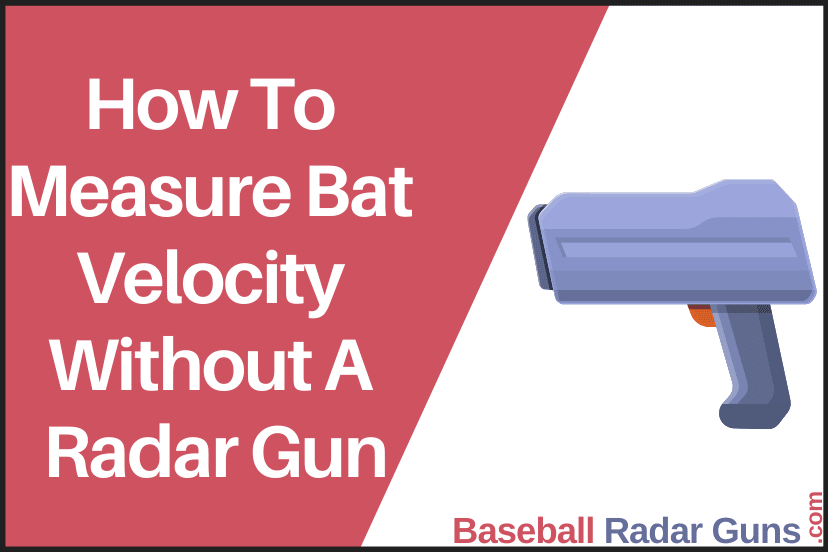How To Measure Bat Velocity Without A Radar Gun
*We may earn a commission for purchases made using our links. Please see our disclosure to learn more.
It is possible to determine bat velocity using a radar gun. However, it is not always accurate. To estimate bat velocity without a radar gun, you need to grasp the foundations of how bats work and how they are measured.
Knowing the bat speed allows you to calculate hit distances and compare different bat types. When calculating bat speed, use the right software; many are inaccurate or unreliable.
Lastly, please take caution when using any measurement instrument, especially phone apps, since they can be dangerous if not utilized correctly.
Without a radar gun, you can estimate bat velocity by timing how long it takes bats to get from one end of the batting cage to the other using a variety of approaches, such as hand-held stopwatches or clapping techniques.
Additionally, you can gauge bat flight speeds by recording it with video equipment, such as a camera mounted on a tripod. If everything else fails and you have no other tools, you can estimate bat velocity by taking a quick look at their bat swing measurements.
Table of Contents
Using a Phone App to Calculate Bat Speed
There are a few ways to calculate bat speed. However, some applications can enable you to do it without using a radar gun. Using an app, you can gauge your bat’s speed in real-time as you swing.
This information should be helpful to athletes who want to improve their batting mechanics and keep track of their progress. You may choose one that meets your demands and budget, such as Bat Speed Pro, which has free and paid versions. The app will also show statistics on how frequently you hit balls of different speeds for batters of all ability levels.
You can witness rapid improvement in your hitting ability by monitoring your growth and performance over time. Another aspect of many apps is the capacity to share data with other users or coaches.
Using an app to monitor bat speed is a simple way to get accurate readings without spending much money or time on setup.
Measuring Swing Wing Span
Measuring bat wing spread is essential when creating your batting cage, especially if you want to maximize the space available for your players. Wing span can be measured with calipers or a measuring tape and should be considered when constructing your batting cage.
By measuring each player’s wingspan, you may create a batting cage that fits their particular size and playing style. Wing span has an impact on the size of the hitting area in your batting cage as well. Calculating the bat’s wing spread and the distance from home plate to first base must take the location of the hands into account.
By keeping these factors in mind, you may create a batting cage that will benefit and please your majority, if not all, your players.
Calculate Bat Swing Time
Bat swing time is essential to achieving your goals during batting practice. The formula to calculate a bat’s flying time is: divided by the time it took to travel that distance in feet.
Knowing how fast your bat moves will help you make better decisions while hitting practice balls. You can calculate the bat’s velocity in feet per second (fps). You can also use radar guns to estimate bat speed, but they are optional.
Be sure to consider wind and weather factors when scheduling your next batting practice session. Keep track of your bat’s flight duration during multiple practices to compare results and improve your skills over time.
When utilizing a radar gun to determine bat speed, keep an eye on the target and adjust your swing. Keep your focus on goal-hitting during practice; using bat speed calculations will speed up the process.
How To Take a Bat Velocity Reading
To calculate the bat velocity reading, you must know how far the first and second bases are from home plate. Ensure your bat is at rest and perpendicular to the ground for an accurate measurement.
Next, multiply the distance between your ball and the ground by your bat velocity in miles per hour (mph; kilometers per hour). Make sure there is a clear path from home plate to first and second bases to measure correctly.
Finally, if necessary, remember to convert inches to meters when calculating your Bat Velocity!
How To Read The Results
Bat speed can be calculated using the average amount of distance traveled per unit of time.
To get the average distance, divide the total distance traveled by the number of time periods recorded. Thanks to this, you’ll be able to gauge the bat’s speed throughout that particular time period.
The potential for power and range of the bat increases with speed. By being aware of the bat speed, coaches and players can improve their skills and performance in drills and games. By understanding how bat speed is measured, players may train more effectively and make better decisions on the field or diamond.
When analyzing bat speed results, it’s essential to consider other factors like arm strength and batted ball speed. With adequate data obtained from numerous tests, analysts can compile a complete analysis of player performance throughout a variety of time periods or seasons.
By employing these easy-to-understand techniques for estimating bat speed, everyone can better understand what certain swings faster than others.
When To Use A Radar Gun To Measure Bat Speed
A radar gun is a helpful tool for assessing bat speed, especially for coaches and players. Before using the radar gun to determine bat speed, a few considerations exist, such as the surface the bats are striking.
Knowing when to use a radar gun will help coaches make better batting practice and gameplay decisions. You can play well or instruct if you are familiar with how a radar gun evaluates bat speed.
Conclusion
Remember that each technique has disadvantages, making it essential to choose the most precise course of action for your unique situation.




